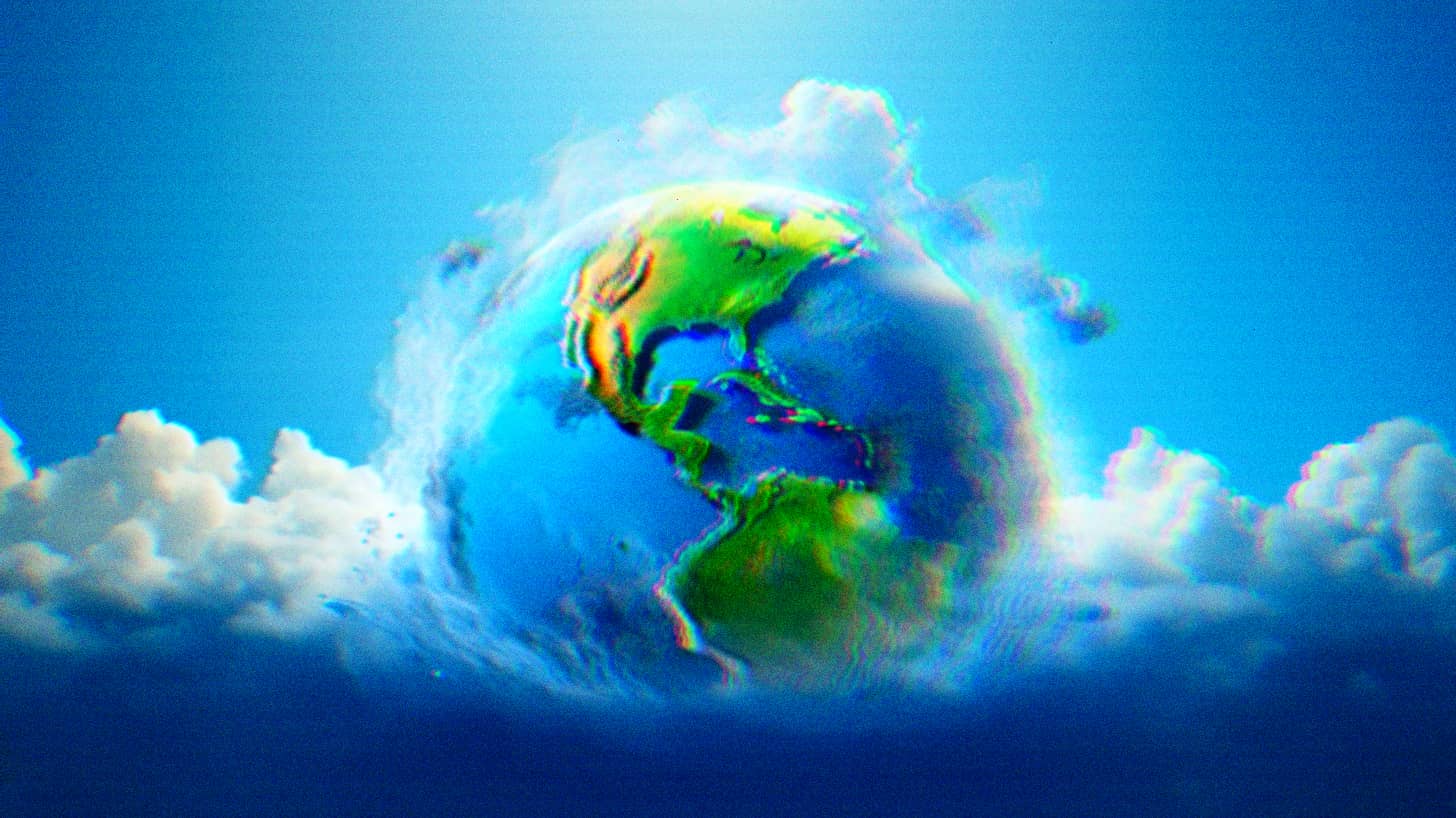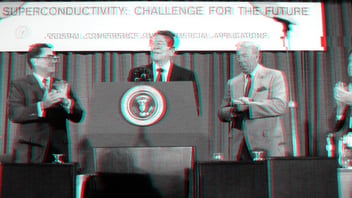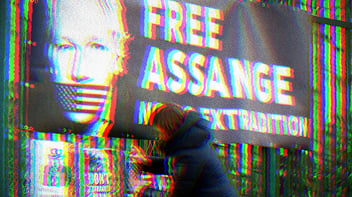The Montreal Protocol.
When we listened to science.
 Image Description: Rendering of the earth and the ozone layer.
Image Description: Rendering of the earth and the ozone layer.
As disgusting as it is to contemplate lining the pockets of the mega corporations, we need to make a deal with the devil to save the planet first. Then we can break them up and tax the living shit out of them and get our money back. In the newsletter this week, I wrote about the mock proceedings of Cop28 in the United Arab Emirates (UAE). A climate conference presided over by the president of an oil and gas company already accused of hacking into conference organizers’ emails and leveraging said conference to set up sales opportunities for new oil and gas leases. If that wasn’t ridiculous enough, in a Q&A session, the executive lambasted the interviewer for suggesting the world phase out fossil fuels, saying it would drive humanity back into caves.
In the past, global conferences have had a positive impact on the world in terms of raising awareness and coordinating efforts between major industrialized nations to set future targets for carbon reduction. Promises are made to hit certain benchmarks, funds are set aside to facilitate clean energy production and transitions in emerging markets, and plans are made to build resilient infrastructure in low lying areas of the world. Diplomats fly in on private jets from all over the world with parameters set forth from their governments as to how far they’re allowed to commit, and then white papers are produced and promptly ignored as we sail into oblivion.
And on Wednesday, I watched part of the Republican side show debate—sans the fascist frontrunner—and was treated to the closing statement from Vivek Ramaswamy, who once again declared that the capstone initiative of his presidency would be the elimination of all policies and agencies designed to prop up the climate agenda hoax.
This was met with applause.
Forget the fact that primary debates are meant to be outrageous and that Ramalamadingdong has as much chance of sitting in the oval office as, well, Chris Christie. It was the applause that killed me. And I get it. I honestly do. Trying to make sense of the narratives and counter narratives espoused by experts and non-experts alike is dizzying. The problem here is that the people in charge of the narratives are the ones with the most to gain or lose by promoting them one way or another, and their positions are dependent upon prevailing conditions that suit their pocketbooks primarily.
Allow me to illustrate.
“Greenflation”
When inflation was peaking throughout the world, the term “greenflation” became a popular talking point among the corporate class and even some policy makers. For example, the European Central Bank (ECB) declared last year that the war in Ukraine was a dark reminder of the need to break from fossil fuel dependency, but that there were economic risks to be weathered in the short-term. Stiff upper lip and all of that. Here’s what they said:
“There is a price to be paid for going green at a pace that reflects the dual objective of safeguarding both our planet and our right to self-determination. But that price, including the fiscal support required to protect the most vulnerable members of society, is worth paying. As we build a more sustainable economy, we face a new age of energy inflation with three distinct but interrelated shocks that can be expected to lead to a prolonged period of upside pressure on inflation.”
Remember that most NGOs and climate organizations were promoting the idea that economies of scale would bring down the cost to produce technologies like wind and solar at scale. Within a determined amount of time, it would become cheaper to produce renewable energy than to burn fossil fuels. And yet, here was the ECB joining with the ranks of the fossil fuel industry to say that going green would be expensive and lead to even more inflation.
So what happened?
The opposite. Goldman Sachs recently released a report that spoke to the collapse in lithium battery prices that have forced EV companies, battery producers and mining operations into a “Bear Market.” Demand growth decreased, but it’s important to note that demand is still increasing. All the while, supply chains were loosening up, subsidies decreased and lithium costs dropped like a fucking stone, thereby obliterating the whole notion of greenflation. And that’s just one example, because this trend carries through to solar manufacturing as well.
My point is that the story goes where the wind blows. Last year, the headline was inflation. So the corporate propaganda machine went into full swing to fear monger around “greenflation.”
(Think windmills kill birds and cause cancer.)
The oligarchy takes whatever scares you the most at that moment and attaches it to a globally coordinated propaganda campaign to ensure that you don’t believe your lying eyes.
It’s cognitive dissonance on a global scale that makes you accept things like having an oil and gas executive lead the world’s foremost conference on climate change. And the biggest lie they tell you is that there’s nothing that can be done.
America is the worst actor in all of this. A study suggested that we should look at ways to phase out gas stoves from multifamily dwellings because the emissions from gas stoves might release carcinogens. And people lost their fucking minds.
Activists tried to empower the public by suggesting we eliminate plastic straws so they don’t get stuck in turtles’ asses and noses; something tangible that can make you feel good that your venti chai latte wasn’t going to give a turtle a chai enema somewhere down the waste stream. And people lost their fucking minds.
But it wasn’t always this way. There was a time that we believed scientists. A time when policy makers worked with scientists and activists to fix shit. The last time it happened on a global scale was in a decade known for anything but selflessness.
The 1980s
As a child of the ‘80s, I can tell you that there were three existential threats that we were all made to fear. Nuclear war with Russia, a hole in the ozone, and the biggest one: quicksand.
Not many of us wound up encountering quicksand, and then Billy Joel played a concert in Leningrad and solved the Cold War. But the hole in the ozone layer was a universal science lesson we all received on the news, in pop culture and in television shows. It was a really big deal.
At some point, the conversation shifted to rising sea levels, climate change, hurricanes, wildfires and natural disasters. Was the hole in the ozone still a problem? Was it responsible for all this stuff? No one was talking.
The scientific consensus—no matter what Ramasmarmy or any of the other climate denying chuckleheads out there say—is that human activity is negatively impacting the environment and causing changes in the climate.
The hole in the ozone layer was really one of the first times the world’s scientists came together to warn us of a very specific threat related to such activity. Here’s an excerpt from the National Oceanic and Atmospheric Administration (NOAA) that best describes this moment:
“In the 1970s, scientists (including several experts from NOAA) discovered that an important function of the stratosphere performed by ozone was impaired by persistent, industrial chemicals known as chlorofluorocarbons (CFCs). These chemicals led to the destruction of ozone molecules and depleted the layer that protects all life on Earth. One key concern was the large “hole” which was opening in the ozone layer each year over Antarctica.
“Stratospheric ozone, which is found about 7-25 miles above the Earth, protects life on the Earth’s surface from the harmful effects of ultraviolet radiation, including skin cancer and weakened immune systems in humans. It also enables healthy ecosystems and productive agriculture.
“Atmospheric scientists identified the actions that humans were taking to cause the stratospheric ozone depletion. Chlorine and bromine, released by the breakdown of CFCs, were particularly problematic. The 1987 Montreal Protocol phased out production and use of these and other substances that deplete ozone.”
Now, think about the timing here. Discovered in the 1970s, and a protocol to combat this trend was agreed upon and implemented in the next decade. In the 1980s. During the Reagan era. Not exactly a time in American history one would closely associate with science and environmentalism.
A PBS documentary explored the miraculous turn of events that drew the U.S. government into the treaty, considering it wasn’t inclined to do so at first. In fact, the documentary showed how Reagan’s Secretary of the Interior Donald Hodel suggested that instead of a treaty, Americans should just wear sunscreen. Now, that’s more like what one would expect these fucknuggets to say.
Some suggest that Reagan’s love of the outdoors and discovery of a cancerous growth on his face shifted his attitude. The more likely story is that the manufacturing industries responsible for products that emitted CFCs had already been developing alternatives and were close to bringing them to market. The government set a date certain in the future to phase out CFCs, and eventually added hydrofluorocarbons (HFCs) found in refrigerants to the mix as they too were found to be part of the problem.
And guess what?
In 2017, scientists discovered that the ozone was beginning to repair itself and the hole was shrinking.
Hairspray
So, that all sounds like great news. We can finally check off the ozone hole and quicksand. Unfortunately, the Russians continue to present a threat, so we’ll miss the trifecta. Also, and this is important, remember that this was the ‘80s. One of the primary products that spewed CFCs into the atmosphere was aerosol sprays.
Hairspray.
They eliminated hairspray in the ‘80s, and the world didn’t come to an end.
If we can get rid of hairspray cans in the ‘80s, we can do anything.
There are a couple of lessons to glean from this. Before we get to them, it’s important to know that as wonderful as it was to see a reversal by the Reagan administration, it took nearly the entire two terms to get there. In fact, as environmental journalist Eugene Linden wrote in an LA Times Op-Ed:
“Between 1978, when the Carter administration was moving toward phase-out, and 1988, just before the Montreal Protocol went into force, some 19 billion pounds of CFCs were produced. Like carbon dioxide molecules, CFCs have a life in the atmosphere that is measured in decades, and so for years after the treaty was ratified the ozone hole continued to grow. It was only in 2017, nearly 30 years after the protocol’s signing, that scientists detected that the ozone hole was beginning to shrink. Sometime after 2050, they estimate, the ozone layer will return to normal… We don’t know how much smaller the ozone hole would have been had the world banned CFCs in 1978.”
The delay was due to coordinated industry lobbying led by DuPont, the largest manufacturer of CFCs at the time. They pressured the Reagan administration to hold on making any commitments until they had sufficiently developed alternatives. By the time public pressure made this an embarrassment, DuPont was ready to go and dropped their resistance to the treaty.
So, no. Reagan was no hero in this scenario. But the key takeaway here is that public pressure campaigns were mounting because citizens and journalists alike believed the science. And corporate industries who were working on alternatives had time to catch up and ensure they would maintain their dominance with replacement products.
Here are the takeaways and lessons from the success of the Montreal Protocol. First off, public pressure is important. It still means something to politicians and to the corporations who try to greenwash their activities. After all, they wouldn’t bother greenwashing if it didn’t matter, right? Secondly, it’s important to have a Democrat in the White House who actually gives a shit about the environment and is willing to stand up to corporate lobbying influences. I say Democrat because it sure as shit isn’t coming from the Republican side. But it obviously matters which Democrat.
Lastly, and here’s the uncomfortable part, we can only do this in partnership with corporate America because we’re out of time and options.
Do I have grander visions of breaking up monopolies, getting money out of politics, chipping away at the deleterious aspects of corrupt capitalist practices, overthrowing the Democratic Party from the inside to wrest control of the political apparatus, and push for hard and near-term deadlines to force a major overhaul to the protein manufacturing and fossil fuel industries? Yes, to all counts. But think of the DuPont example.
While we’re battling for control in the United States, we actually need our mega-corporations to succeed in transitioning their business models through whatever incentives are possible. I don’t care if ExxonMobil becomes the largest renewable energy player in the world. Don’t care if Koch Industries decides to abandon harmful chemical agents in their portfolio of companies. It doesn’t matter who gets it done, so long as it gets done. And the way to get there is by electing progressives who understand the existential threat posed by climate change and the economics of the current system that requires massive government intervention in favor of companies willing to transition away from bad practices.
Max is a political commentator and essayist who focuses on the intersection of American socioeconomic theory and politics in the modern era. He is the publisher of UNFTR Media and host of the popular Unf*cking the Republic® podcast and YouTube channel. Prior to founding UNFTR, Max spent fifteen years as a publisher and columnist in the alternative newsweekly industry and a decade in terrestrial radio. Max is also a regular contributor to the MeidasTouch Network where he covers the U.S. economy.


